Qi She
Beyond Attention or Similarity: Maximizing Conditional Diversity for Token Pruning in MLLMs
Jun 12, 2025Abstract:In multimodal large language models (MLLMs), the length of input visual tokens is often significantly greater than that of their textual counterparts, leading to a high inference cost. Many works aim to address this issue by removing redundant visual tokens. However, current approaches either rely on attention-based pruning, which retains numerous duplicate tokens, or use similarity-based pruning, overlooking the instruction relevance, consequently causing suboptimal performance. In this paper, we go beyond attention or similarity by proposing a novel visual token pruning method named CDPruner, which maximizes the conditional diversity of retained tokens. We first define the conditional similarity between visual tokens conditioned on the instruction, and then reformulate the token pruning problem with determinantal point process (DPP) to maximize the conditional diversity of the selected subset. The proposed CDPruner is training-free and model-agnostic, allowing easy application to various MLLMs. Extensive experiments across diverse MLLMs show that CDPruner establishes new state-of-the-art on various vision-language benchmarks. By maximizing conditional diversity through DPP, the selected subset better represents the input images while closely adhering to user instructions, thereby preserving strong performance even with high reduction ratios. When applied to LLaVA, CDPruner reduces FLOPs by 95\% and CUDA latency by 78\%, while maintaining 94\% of the original accuracy. Our code is available at https://github.com/Theia-4869/CDPruner.
TimeSearch: Hierarchical Video Search with Spotlight and Reflection for Human-like Long Video Understanding
Apr 02, 2025Abstract:Large video-language models (LVLMs) have shown remarkable performance across various video-language tasks. However, they encounter significant challenges when processing long videos because of the large number of video frames involved. Downsampling long videos in either space or time can lead to visual hallucinations, making it difficult to accurately interpret long videos. Motivated by human hierarchical temporal search strategies, we propose \textbf{TimeSearch}, a novel framework enabling LVLMs to understand long videos in a human-like manner. TimeSearch integrates two human-like primitives into a unified autoregressive LVLM: 1) \textbf{Spotlight} efficiently identifies relevant temporal events through a Temporal-Augmented Frame Representation (TAFR), explicitly binding visual features with timestamps; 2) \textbf{Reflection} evaluates the correctness of the identified events, leveraging the inherent temporal self-reflection capabilities of LVLMs. TimeSearch progressively explores key events and prioritizes temporal search based on reflection confidence. Extensive experiments on challenging long-video benchmarks confirm that TimeSearch substantially surpasses previous state-of-the-art, improving the accuracy from 41.8\% to 51.5\% on the LVBench. Additionally, experiments on temporal grounding demonstrate that appropriate TAFR is adequate to effectively stimulate the surprising temporal grounding ability of LVLMs in a simpler yet versatile manner, which improves mIoU on Charades-STA by 11.8\%. The code will be released.
ASGDiffusion: Parallel High-Resolution Generation with Asynchronous Structure Guidance
Dec 09, 2024Abstract:Training-free high-resolution (HR) image generation has garnered significant attention due to the high costs of training large diffusion models. Most existing methods begin by reconstructing the overall structure and then proceed to refine the local details. Despite their advancements, they still face issues with repetitive patterns in HR image generation. Besides, HR generation with diffusion models incurs significant computational costs. Thus, parallel generation is essential for interactive applications. To solve the above limitations, we introduce a novel method named ASGDiffusion for parallel HR generation with Asynchronous Structure Guidance (ASG) using pre-trained diffusion models. To solve the pattern repetition problem of HR image generation, ASGDiffusion leverages the low-resolution (LR) noise weighted by the attention mask as the structure guidance for the denoising step to ensure semantic consistency. The proposed structure guidance can significantly alleviate the pattern repetition problem. To enable parallel generation, we further propose a parallelism strategy, which calculates the patch noises and structure guidance asynchronously. By leveraging multi-GPU parallel acceleration, we significantly accelerate generation speed and reduce memory usage per GPU. Extensive experiments demonstrate that our method effectively and efficiently addresses common issues like pattern repetition and achieves state-of-the-art HR generation.
[CLS] Attention is All You Need for Training-Free Visual Token Pruning: Make VLM Inference Faster
Dec 02, 2024![Figure 1 for [CLS] Attention is All You Need for Training-Free Visual Token Pruning: Make VLM Inference Faster](/_next/image?url=https%3A%2F%2Ffigures.semanticscholar.org%2Fb02159650df9813f25db4afd4f094e53bccd526c%2F8-Table1-1.png&w=640&q=75)
![Figure 2 for [CLS] Attention is All You Need for Training-Free Visual Token Pruning: Make VLM Inference Faster](/_next/image?url=https%3A%2F%2Ffigures.semanticscholar.org%2Fb02159650df9813f25db4afd4f094e53bccd526c%2F2-Figure2-1.png&w=640&q=75)
![Figure 3 for [CLS] Attention is All You Need for Training-Free Visual Token Pruning: Make VLM Inference Faster](/_next/image?url=https%3A%2F%2Ffigures.semanticscholar.org%2Fb02159650df9813f25db4afd4f094e53bccd526c%2F5-Figure3-1.png&w=640&q=75)
![Figure 4 for [CLS] Attention is All You Need for Training-Free Visual Token Pruning: Make VLM Inference Faster](/_next/image?url=https%3A%2F%2Ffigures.semanticscholar.org%2Fb02159650df9813f25db4afd4f094e53bccd526c%2F9-Table3-1.png&w=640&q=75)
Abstract:Large vision-language models (VLMs) often rely on a substantial number of visual tokens when interacting with large language models (LLMs), which has proven to be inefficient. Recent efforts have aimed to accelerate VLM inference by pruning visual tokens. Most existing methods assess the importance of visual tokens based on the text-visual cross-attentions in LLMs. In this study, we find that the cross-attentions between text and visual tokens in LLMs are inaccurate. Pruning tokens based on these inaccurate attentions leads to significant performance degradation, especially at high reduction ratios. To this end, we introduce FasterVLM, a simple yet effective training-free visual token pruning method that evaluates the importance of visual tokens more accurately by utilizing attentions between the [CLS] token and image tokens from the visual encoder. Since FasterVLM eliminates redundant visual tokens immediately after the visual encoder, ensuring they do not interact with LLMs and resulting in faster VLM inference. It is worth noting that, benefiting from the accuracy of [CLS] cross-attentions, FasterVLM can prune 95\% of visual tokens while maintaining 90\% of the performance of LLaVA-1.5-7B. We apply FasterVLM to various VLMs, including LLaVA-1.5, LLaVA-NeXT, and Video-LLaVA, to demonstrate its effectiveness. Experimental results show that our FasterVLM maintains strong performance across various VLM architectures and reduction ratios, significantly outperforming existing text-visual attention-based methods. Our code is available at https://github.com/Theia-4869/FasterVLM.
MC-LLaVA: Multi-Concept Personalized Vision-Language Model
Nov 18, 2024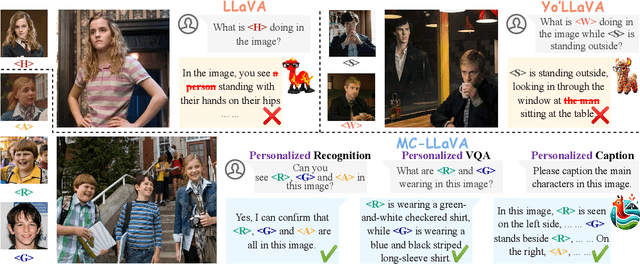

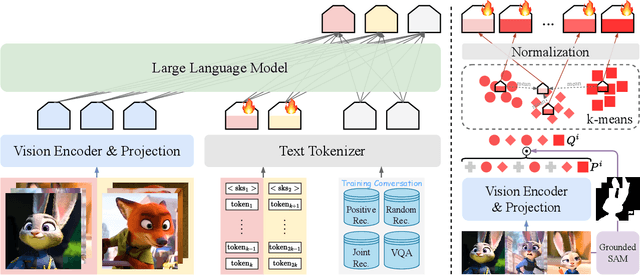

Abstract:Current vision-language models (VLMs) show exceptional abilities across diverse tasks including visual question answering. To enhance user experience in practical applications, recent studies investigate VLM personalization to understand user-provided concepts. However, existing studies mainly focus on single-concept personalization, neglecting the existence and interplay of multiple concepts, which limits the real-world applicability of personalized VLMs. In this paper, we propose the first multi-concept personalization method named MC-LLaVA along with a high-quality multi-concept personalization dataset. Specifically, MC-LLaVA uses a joint training strategy incorporating multiple concepts in a single training step, allowing VLMs to perform accurately in multi-concept personalization. To reduce the cost of joint training, MC-LLaVA leverages visual token information for concept token initialization, yielding improved concept representation and accelerating joint training. To advance multi-concept personalization research, we further contribute a high-quality dataset. We carefully collect images from various movies that contain multiple characters and manually generate the multi-concept question-answer samples. Our dataset features diverse movie types and question-answer types. We conduct comprehensive qualitative and quantitative experiments to demonstrate that MC-LLaVA can achieve impressive multi-concept personalized responses, paving the way for VLMs to become better user-specific assistants. The code and dataset will be publicly available at https://github.com/arctanxarc/MC-LLaVA.
MammothModa: Multi-Modal Large Language Model
Jun 26, 2024Abstract:In this report, we introduce MammothModa, yet another multi-modal large language model (MLLM) designed to achieve state-of-the-art performance starting from an elementary baseline. We focus on three key design insights: (i) Integrating Visual Capabilities while Maintaining Complex Language Understanding: In addition to the vision encoder, we incorporated the Visual Attention Experts into the LLM to enhance its visual capabilities. (ii) Extending Context Window for High-Resolution and Long-Duration Visual Feature: We explore the Visual Merger Module to effectively reduce the token number of high-resolution images and incorporated frame position ids to avoid position interpolation. (iii) High-Quality Bilingual Datasets: We meticulously curated and filtered a high-quality bilingual multimodal dataset to reduce visual hallucinations. With above recipe we build MammothModa that consistently outperforms the state-of-the-art models, e.g., LLaVA-series, across main real-world visual language benchmarks without bells and whistles.
PDO-s3DCNNs: Partial Differential Operator Based Steerable 3D CNNs
Aug 07, 2022
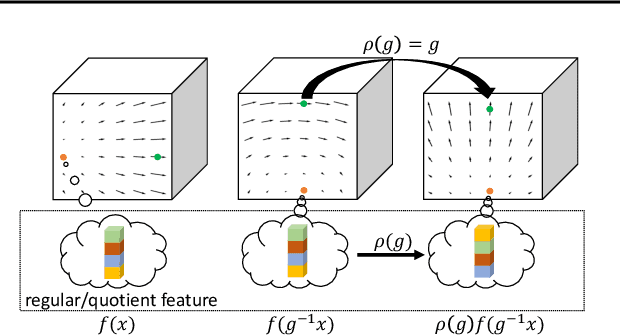


Abstract:Steerable models can provide very general and flexible equivariance by formulating equivariance requirements in the language of representation theory and feature fields, which has been recognized to be effective for many vision tasks. However, deriving steerable models for 3D rotations is much more difficult than that in the 2D case, due to more complicated mathematics of 3D rotations. In this work, we employ partial differential operators (PDOs) to model 3D filters, and derive general steerable 3D CNNs, which are called PDO-s3DCNNs. We prove that the equivariant filters are subject to linear constraints, which can be solved efficiently under various conditions. As far as we know, PDO-s3DCNNs are the most general steerable CNNs for 3D rotations, in the sense that they cover all common subgroups of $SO(3)$ and their representations, while existing methods can only be applied to specific groups and representations. Extensive experiments show that our models can preserve equivariance well in the discrete domain, and outperform previous works on SHREC'17 retrieval and ISBI 2012 segmentation tasks with a low network complexity.
On Learning Contrastive Representations for Learning with Noisy Labels
Mar 25, 2022



Abstract:Deep neural networks are able to memorize noisy labels easily with a softmax cross-entropy (CE) loss. Previous studies attempted to address this issue focus on incorporating a noise-robust loss function to the CE loss. However, the memorization issue is alleviated but still remains due to the non-robust CE loss. To address this issue, we focus on learning robust contrastive representations of data on which the classifier is hard to memorize the label noise under the CE loss. We propose a novel contrastive regularization function to learn such representations over noisy data where label noise does not dominate the representation learning. By theoretically investigating the representations induced by the proposed regularization function, we reveal that the learned representations keep information related to true labels and discard information related to corrupted labels. Moreover, our theoretical results also indicate that the learned representations are robust to the label noise. The effectiveness of this method is demonstrated with experiments on benchmark datasets.
Weakly Supervised Object Localization as Domain Adaption
Mar 25, 2022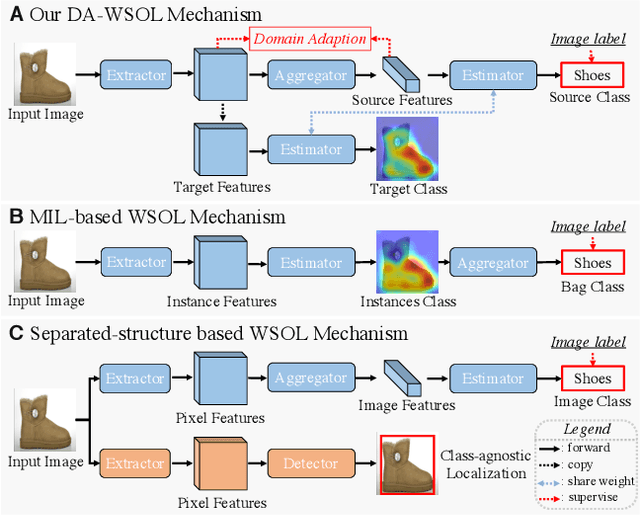
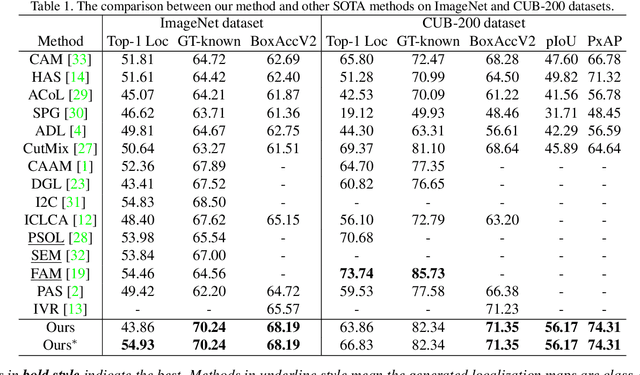
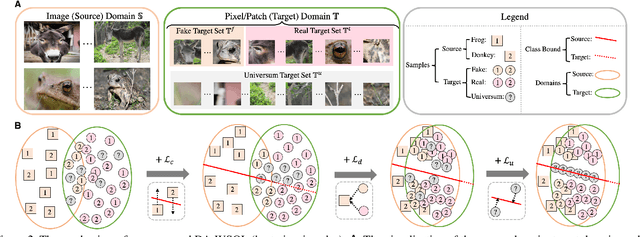
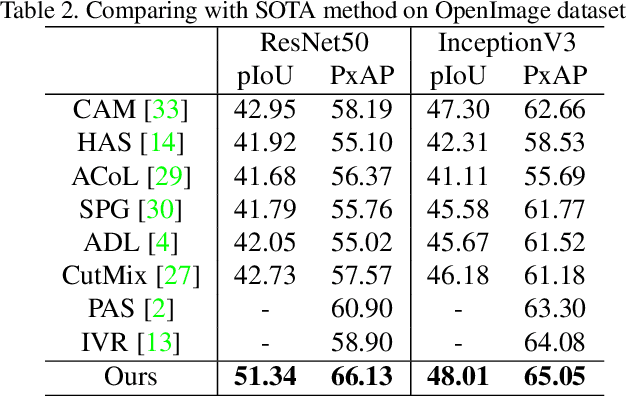
Abstract:Weakly supervised object localization (WSOL) focuses on localizing objects only with the supervision of image-level classification masks. Most previous WSOL methods follow the classification activation map (CAM) that localizes objects based on the classification structure with the multi-instance learning (MIL) mechanism. However, the MIL mechanism makes CAM only activate discriminative object parts rather than the whole object, weakening its performance for localizing objects. To avoid this problem, this work provides a novel perspective that models WSOL as a domain adaption (DA) task, where the score estimator trained on the source/image domain is tested on the target/pixel domain to locate objects. Under this perspective, a DA-WSOL pipeline is designed to better engage DA approaches into WSOL to enhance localization performance. It utilizes a proposed target sampling strategy to select different types of target samples. Based on these types of target samples, domain adaption localization (DAL) loss is elaborated. It aligns the feature distribution between the two domains by DA and makes the estimator perceive target domain cues by Universum regularization. Experiments show that our pipeline outperforms SOTA methods on multi benchmarks. Code are released at \url{https://github.com/zh460045050/DA-WSOL_CVPR2022}.
Background-aware Classification Activation Map for Weakly Supervised Object Localization
Dec 29, 2021

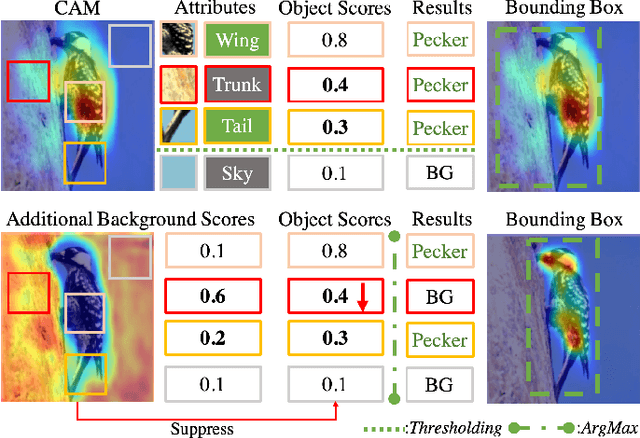
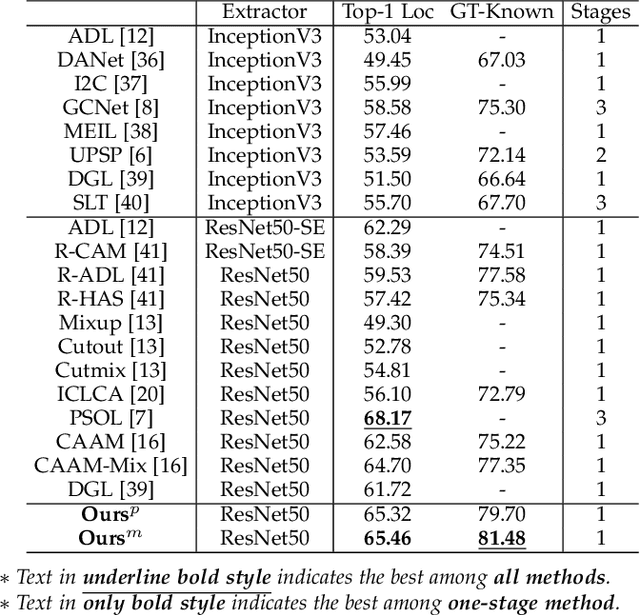
Abstract:Weakly supervised object localization (WSOL) relaxes the requirement of dense annotations for object localization by using image-level classification masks to supervise its learning process. However, current WSOL methods suffer from excessive activation of background locations and need post-processing to obtain the localization mask. This paper attributes these issues to the unawareness of background cues, and propose the background-aware classification activation map (B-CAM) to simultaneously learn localization scores of both object and background with only image-level labels. In our B-CAM, two image-level features, aggregated by pixel-level features of potential background and object locations, are used to purify the object feature from the object-related background and to represent the feature of the pure-background sample, respectively. Then based on these two features, both the object classifier and the background classifier are learned to determine the binary object localization mask. Our B-CAM can be trained in end-to-end manner based on a proposed stagger classification loss, which not only improves the objects localization but also suppresses the background activation. Experiments show that our B-CAM outperforms one-stage WSOL methods on the CUB-200, OpenImages and VOC2012 datasets.
 Add to Chrome
Add to Chrome Add to Firefox
Add to Firefox Add to Edge
Add to Edge